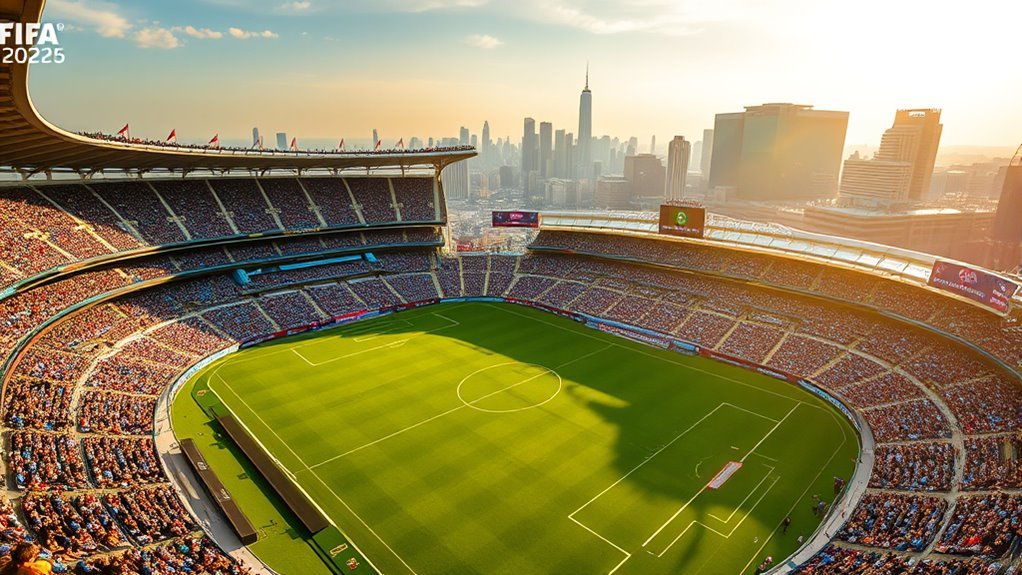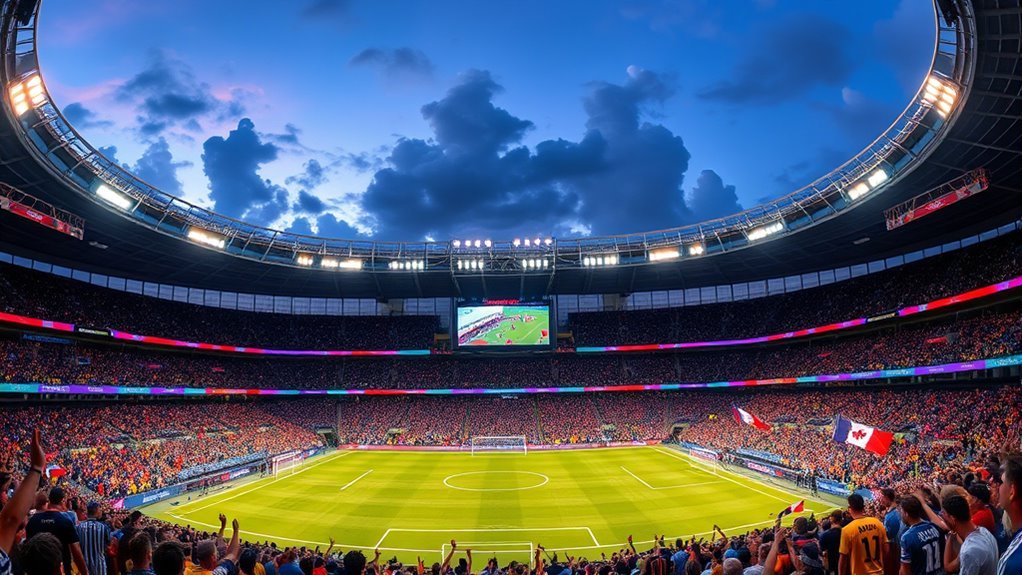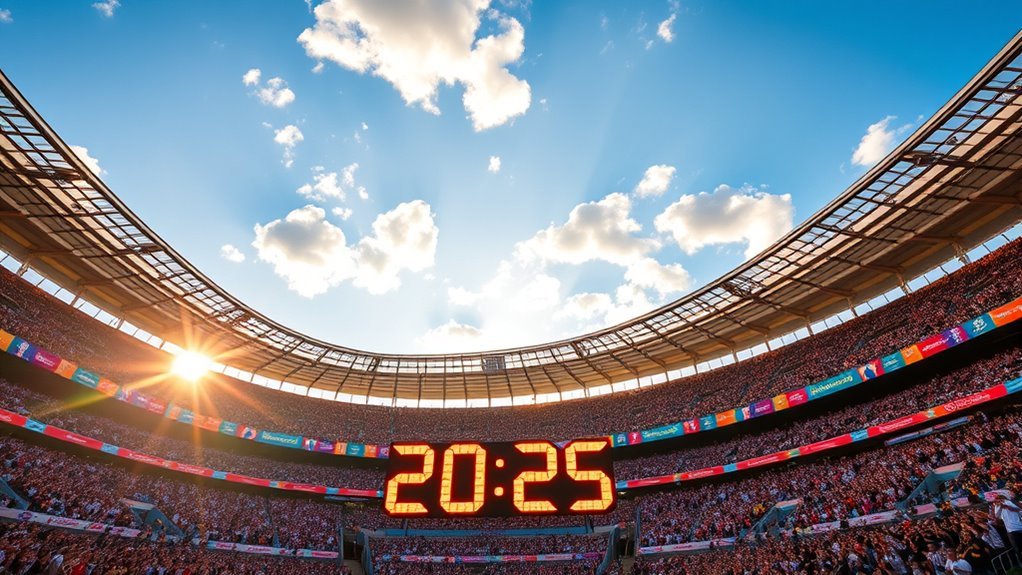The FIFA World Cup 2026 is set to take place in multiple iconic stadiums across the U.S., Canada, and Mexico. You’ll find venues like MetLife Stadium in New Jersey, SoFi Stadium in Los Angeles, and the historic Estadio Azteca in Mexico City, all featuring modern designs and sustainability initiatives. Each stadium offers unique fan experiences, blending local culture with excitement. If you want to learn more about these amazing venues, keep exploring!
Overview of the FIFA World Cup 2026 Stadiums
As you look forward to the FIFA World Cup 2026, it’s exciting to know that the tournament will be hosted across multiple iconic stadiums in the United States, Canada, and Mexico. These venues not only capture the spirit of the game but also embrace sustainability initiatives, ensuring a positive impact on the environment.
Each stadium will showcase impressive architectural designs, blending modern aesthetics with cultural significance. You’ll see how these structures reflect their local communities, fostering a sense of pride and unity among fans.
As the tournament approaches, expect to hear more about innovative features aimed at reducing energy consumption and promoting eco-friendly practices. This commitment to sustainability aligns with the growing desire for freedom in our choices, making it easier for fans to enjoy the beautiful game while supporting responsible development. So get ready to experience a World Cup that champions both sport and our planet!
Key Host Cities and Their Stadiums
With excitement building for the FIFA World Cup 2026, fans can look forward to matches in some of the most vibrant cities across the U.S., Canada, and Mexico. Each host city brings its own unique flavor and stunning stadiums, designed with both architectural brilliance and stadium accessibility in mind. Here are some key cities and their stadiums:
Excitement is soaring for the FIFA World Cup 2026, showcasing vibrant cities and stunning, accessible stadiums across North America.
- New York/New Jersey – MetLife Stadium, a marvel of modern design, offers expansive seating and exceptional amenities.
- Los Angeles – SoFi Stadium, known for its sleek architecture, provides a unique fan experience with cutting-edge technology.
- Toronto – BMO Field, a cozy gem that emphasizes accessibility, ensuring everyone can enjoy the action.
- Mexico City – Estadio Azteca, a historic venue with an awe-inspiring design, invites fans to be part of World Cup history.
Get ready to experience the thrill of soccer in these iconic locations!
Notable Features of Each Stadium
Each stadium in the FIFA World Cup 2026 lineup boasts unique features that enhance the fan experience and showcase the spirit of the host cities. You’re gonna love how these venues blend cutting-edge architectural designs with local culture, creating a vibrant atmosphere. Many stadiums are embracing sustainability initiatives, using eco-friendly materials and energy-efficient systems that reflect a commitment to a greener future.
For instance, some venues incorporate green roofs and advanced water conservation systems, ensuring they minimize their environmental impact without sacrificing comfort. You’ll appreciate the open layouts and views that connect fans with the action on the field while celebrating the surrounding landscapes. In addition, these stadiums often feature interactive areas where you can immerse yourself in the local history and traditions, making every visit memorable. Whether it’s the sleek lines of modern structures or the warmth of classic designs, each stadium offers a unique experience.
History and Significance of Selected Venues
While exploring the history and significance of selected venues for the FIFA World Cup 2026, you’ll find that these stadiums are not just places for sporting events; they’re iconic landmarks that reflect the rich cultural heritage of their cities. Each venue tells a unique story, often showcasing architectural innovations that stand the test of time. Here are a few highlights:
- MetLife Stadium – Known for its modern design, it’s a hub for both sports and concerts, symbolizing New Jersey’s vibrant culture.
- Lumen Field – This Seattle venue is famous for its loud atmosphere, reflecting the city’s passionate sports fans.
- Rose Bowl – A historic site, it has hosted numerous significant events, showcasing its historical significance.
- Mercedes-Benz Stadium – Featuring a retractable roof, it represents cutting-edge architecture and Atlanta’s forward-thinking spirit.
These venues embody the spirit of freedom and unity that the World Cup celebrates.
Anticipated Fan Experience and Amenities
How can fans expect to immerse themselves in the excitement of the FIFA World Cup 2026? You’re in for a treat! This tournament promises to elevate fan engagement to new heights with cutting-edge interactive experiences. Picture yourself stepping into the stadium, greeted by vibrant displays and technology that connects you with fellow supporters.
You won’t just watch the matches; you’ll feel part of the action, thanks to augmented reality features and engaging apps that let you vote on in-game moments or relive highlights in real-time. Food stalls will offer global cuisine, reflecting the diverse cultures coming together for this event.
Plus, designated fan zones will allow you to mingle and celebrate, making unforgettable memories. With all these amenities and experiences designed just for you, the FIFA World Cup 2026 aims to create a sense of freedom and joy that every fan deserves. Get ready for an unforgettable journey!
Importance of Stadium Selection for the Tournament
When it comes to the FIFA World Cup 2026, choosing the right stadium is essential for a successful tournament. You’ll want to take into account how the venue can boost the local economy and enhance the overall fan experience. The right selection can create lasting memories for attendees and provide significant benefits for the host city.
Economic Impact Considerations
The economic impact of selecting the right stadiums for the 2026 FIFA World Cup cannot be overstated, as it directly influences local businesses, tourism, and infrastructure development. Choosing the right venues creates significant investment opportunities that can elevate communities. Here’s how:
- Increased Foot Traffic: More visitors mean more customers for local businesses.
- Job Creation: Stadium construction and event staffing provide employment opportunities.
- Tourism Boost: Fans from around the globe will explore the host cities, enhancing hotel and restaurant revenues.
- Infrastructure Improvement: Upgraded facilities and transportation systems benefit everyone long after the tournament ends.
Fan Experience Enhancement
Selecting the right stadiums for the 2026 FIFA World Cup goes beyond just economic benefits; it greatly shapes the fan experience. The atmosphere, accessibility, and facilities all contribute to how you enjoy the event. Stadiums should promote fan engagement and offer interactive experiences that make the tournament unforgettable.
| Aspect | Importance |
|---|---|
| Atmosphere | Creates excitement and connection |
| Accessibility | Guarantees ease of movement and comfort |
| Facilities | Enhances overall enjoyment |
| Interactive Activities | Engages fans beyond the game |
Frequently Asked Questions
How Many Stadiums Will Host Matches in the 2026 World Cup?
There’ll be 16 stadium locations hosting matches in the 2026 World Cup. You’ll want to check the match schedules to catch your favorite teams. It’s all about embracing the excitement and freedom of this global event!
Will There Be Any New Stadiums Constructed for the Tournament?
Yes, there’ll likely be new stadiums constructed for the tournament, though construction updates are still emerging. You can expect some exciting developments as cities prepare to host this grand event, embracing the spirit of freedom and celebration.
What Is the Seating Capacity of Each Host Stadium?
Each host stadium’s seating capacity varies, often influenced by stadium renovations and unique seating configurations. You’ll find capacities ranging from around 40,000 to over 80,000, creating an exhilarating atmosphere for fans seeking freedom in cheering.
Are There Any Specific Sustainability Initiatives for the Stadiums?
Yes, you’ll find various sustainability initiatives, including green architecture and efficient waste management practices at the stadiums. These efforts aim to minimize environmental impact while promoting a sense of freedom in enjoying the beautiful game.
How Will Ticket Sales Be Managed for the Tournament?
Ticket sales will use dynamic pricing to adjust costs based on demand, ensuring accessibility. You’ll see enhanced fan engagement through interactive platforms, making your experience more enjoyable and allowing you to secure tickets more freely.




